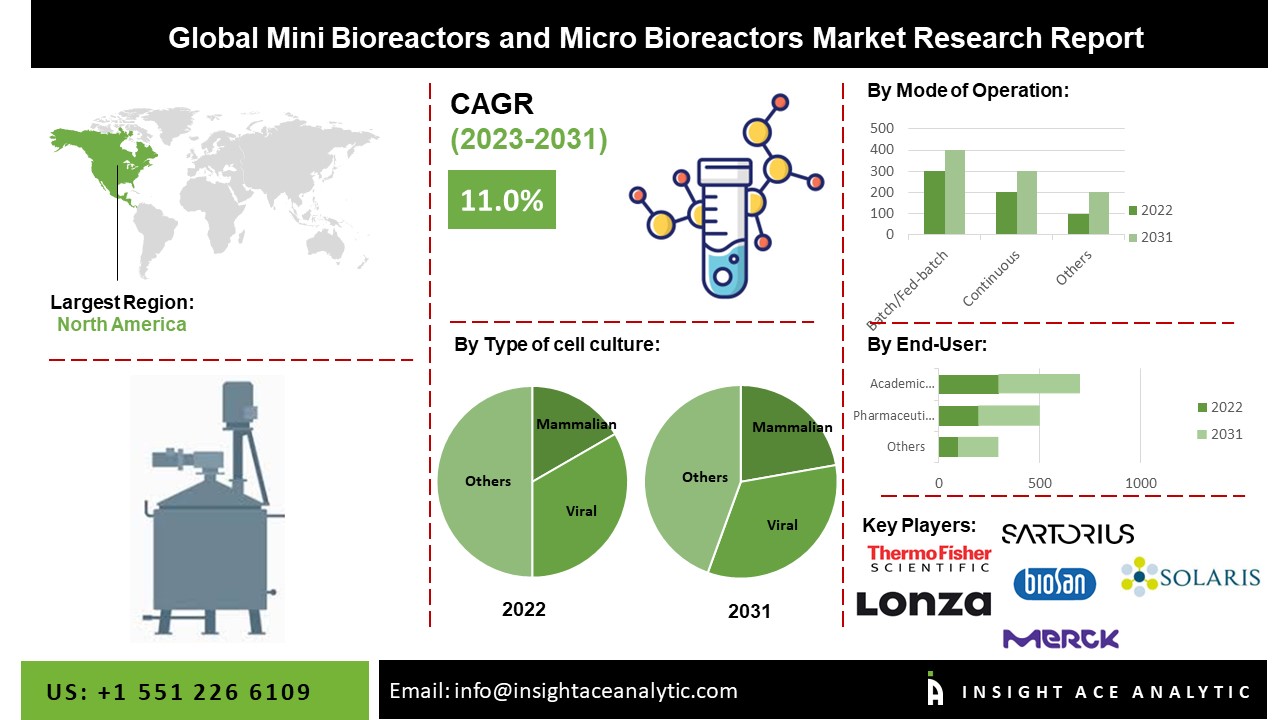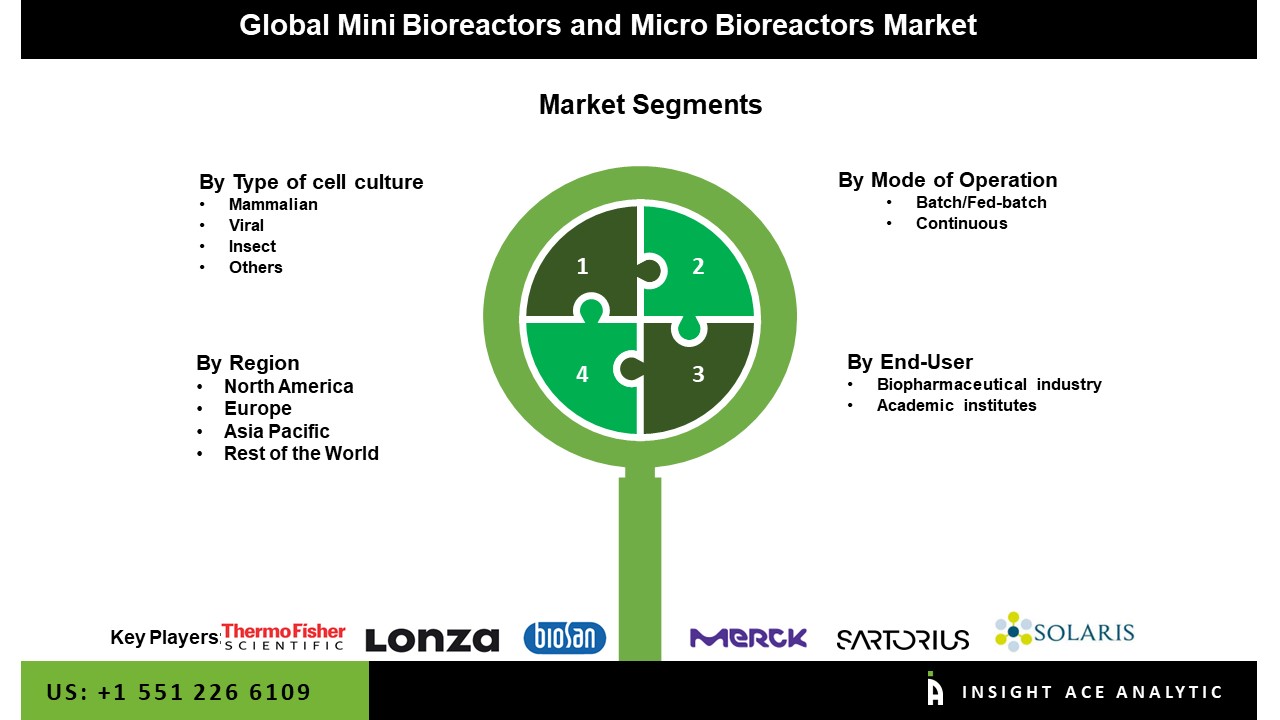The Mini Bioreactors and Micro Bioreactors Market is expected to grow at a 11.0 % CAGR during the forecast period for 2023-2031.

Traditional methods for growing microbial cells have lagged behind automated technologies based on arrays for manipulating DNA and uncovering biological systems. Systems that enable optimization, quick testing, and bioprocess development in low volume, parallel research with setup, and in a short amount of time are therefore required. These systems must also stay almost independent of the number of bioreactors. Micro bioreactors are a step toward developing high-throughput bioprocesses. They are made by combining automated sensors and actuators with polymer-based micro bioreactor manufacturing, design, production, and characterization processes.
The micro bioreactors combine manufactured polymer micro-optical lenses and plug-and-flow microfluidic connectors for quick setup and simplicity of use. Micro bioreactors can also be used in a variety of ways to cultivate microbial cells for batch, continuous, and fed-batch operations. The usage of this approach for the generation of various byproducts is predicted to increase, leading to a significant increase in the global micro bioreactors market's revenue over the ensuing years. With a growth in R&D investment in the industrial and life sciences sectors, notably in the pharmaceutical and food and beverage sector, it is projected that the need for micro bioreactor technology would expand.
Additionally, compared to large-scale fermentations, micro bioreactors offer flexibility and controller of bench-scale reactors, resulting in quicker and more accurate results. The availability of online cultivation data, as well as other benefits offered by manufacturers such as a small footprint and the opportunity for automation, are anticipated to drive up demand for micro bioreactors throughout the course of the projection period. Nevertheless, despite the fact that the micro bioreactors industry is anticipated to experience significant growth throughout the projected period, regulatory issues could restrain the market's expansion. Additionally, emerging nations' lack of knowledge and experience could slow the rate of revenue growth over the forecast period.
The Mini Bioreactors and Micro Bioreactors market is segmented on the basis of distribution by type of cell culture, mode of operation, and end-user. Based on distribution by type of cell culture, the market is segmented as Mammalian, Microbial, Viral, Insect, and Others. By mode of operation, the market is segmented into Batch/Fed-Batch, and Continuous. By end-user, the market is segmented into Biopharmaceutical Industry and Academic Institutes.
Micro-Bioreactors are widely used in academic institutes to provide live exposure to technical knowledge to students or professionals. Most educational institutions in the health, pharmaceutical, food, and chemical industries are expanding, emphasizing new technologies to satisfy market demands for sustainable technology. During the projected period, there will be a considerable increase in the demand for micro bioreactors from Academic institutions around the world due to the significant increase in their investments in research activities in targeted medicines, regenerative medicines, and cell culture medium.
Shake flasks and microliter plates are used for primary and secondary screening investigations based on microbial libraries. The selection of the most promising microbial strain candidates is aided by this screening procedure. Selected microbial candidates are subsequently subjected to laboratory-scale experimental settings to enhance bioprocess control. After successful lab-scale testing, the micro bioreactor-developed bioprocess technology is scaled up to the pilot level. Pilot-scale testing is essential to grasp the bioreactor inhomogeneities, which may eventually be addressed using simulators that can scale down the bioreactor process. These improvements in procedures are accelerating the market's growth in the microbiological sector.
Owing to the inclusion of industry participants, the small-scale bioreactors market in North America is anticipated to grow significantly over the next years. For instance, on July 15, 2021, the H.E.L Group (H.E.L), a developer and manufacturer of tools used in laboratories for processing optimization, scale-up, and safety, announced that the company had expanded its operations to include sales, instrument service, and technical and field application support in regions of North America by opening a West Coast hub in California and a Central Region hub in Missouri.
Furthermore, due to significant technological developments made in the field of bioprocessing systems and the rising popularity of micro-bioreactors, North America dominated the global market. The region's wealth of biopharmaceutical companies and equipment suppliers is another factor contributing to North America's dominance in the global micro-bioreactors market.
Local enterprises stoked demand for micro-bioreactors in the area, and it is anticipated that demand will continue strong in the anticipated years.
| Report Attribute | Specifications |
| Growth Rate CAGR | CAGR of 11.0 % from 2023 to 2031 |
| Quantitative Units | Representation of revenue in US$ Million, Volume (Unit), and CAGR from 2023 to 2031 |
| Historic Year | 2019 to 2022 |
| Forecast Year | 2023-2031 |
| Report Coverage | The forecast of revenue, the position of the company, the competitive market structure, growth prospects, and trends |
| Segments Covered | By Type of Cell Culture, By Mode of Operation, By End-User |
| Regional Scope | North America; Europe; Asia Pacific; Latin America; Middle East & Africa |
| Country Scope | U.S.; Canada; U.K.; Germany; China; India; Japan; Brazil; Mexico; The UK; France; Italy; Spain; China; Japan; India; South Korea; South East Asia; South Korea; South East Asia |
| Competitive Landscape | Sartorius AG, Thermo Fisher Scientific Inc., Merck KGaA, Danaher Corporation, Lonza Group, Eppendorf AG, Miltenyi Biotec, Getinge AB, Solaris Biotechnology Srl, Infors AG, Biosan, MicroDigital Co., Ltd., 2mag AG, MDX Biotechnik International GmbH, Esco Lifesciences Group, HiTec Zang GmbH, Hanil Scientific Inc., Adolf Kühner AG, Ori Biotech, Aglaris, and AdvaBio. |
| Customization Scope | Free customization report with the procurement of the report, Modifications to the regional and segment scope. Particular Geographic competitive landscape. |
| Pricing and Available Payment Methods | Explore pricing alternatives that are customized to your particular study requirements. |
Segmentation of Mini Bioreactors and Micro Bioreactors Market-
By Type of Cell Culture-

By Mode of Operation-
By End-user-
By Region-
North America-
Europe-
Asia-Pacific-
Latin America-
Middle East & Africa-
Chapter 1. Methodology and Scope
1.1. Research Methodology
1.2. Research Scope & Assumptions
Chapter 2. Executive Summary
Chapter 3. Global Mini Bioreactors and Micro Bioreactors Market Snapshot
Chapter 4. Global Mini Bioreactors and Micro Bioreactors Market Variables, Trends & Scope
4.1. Market Segmentation & Scope
4.2. Drivers
4.3. Challenges
4.4. Trends
4.5. Investment and Funding Analysis
4.6. Industry Analysis – Porter’s Five Forces Analysis
4.7. Competitive Landscape & Market Share Analysis
4.8. Impact of Covid-19 Analysis
Chapter 5. Market Segmentation 1: By Type of Cell Culture Estimates & Trend Analysis
5.1. By Type of Cell Culture & Market Share, 2020 & 2030
5.2. Market Size (Value US$ Mn) & Forecasts and Trend Analyses, 2020 to 2030 for the following By Type of Cell Culture:
5.2.1. Mammalian
5.2.2. Microbial
5.2.3. Viral
5.2.4. Insect
5.2.5. Others
Chapter 6. Market Segmentation 2: By Mode of Operation Estimates & Trend Analysis
6.1. By Mode of Operation & Market Share, 2020 & 2030
6.2. Market Size (Value US$ Mn) & Forecasts and Trend Analyses, 2020 to 2030 for the following By Mode of Operation:
6.2.1. Batch/Fed-Batch
6.2.2. Continuous
Chapter 7. Market Segmentation 3: By End-user Estimates & Trend Analysis
7.1. By End-user & Market Share, 2020 & 2030
7.2. Market Size (Value US$ Mn) & Forecasts and Trend Analyses, 2020 to 2030 for the following By End-user:
7.2.1. Biopharmaceutical Industry
7.2.2. Academic Institutes
Chapter 8. Mini Bioreactors and Micro Bioreactors Market Segmentation 4: Regional Estimates & Trend Analysis
8.1. North America
8.1.1. North America Mini Bioreactors and Micro Bioreactors Market revenue (US$ Million) estimates and forecasts By Type of Cell Culture, 2020-2030
8.1.2. North America Mini Bioreactors and Micro Bioreactors Market revenue (US$ Million) estimates and forecasts By Mode of Operation, 2020-2030
8.1.3. North America Mini Bioreactors and Micro Bioreactors Market revenue (US$ Million) estimates and forecasts by End-user, 2020-2030
8.1.4. North America Mini Bioreactors and Micro Bioreactors Market revenue (US$ Million) estimates and forecasts by country, 2020-2030
8.2. Europe
8.2.1. Europe Mini Bioreactors and Micro Bioreactors Market revenue (US$ Million) By Type of Cell Culture, 2020-2030
8.2.2. Europe Mini Bioreactors and Micro Bioreactors Market revenue (US$ Million) By Mode of Operation, 2020-2030
8.2.3. Europe Mini Bioreactors and Micro Bioreactors Market revenue (US$ Million) estimates and forecasts by End-user, 2020-2030
8.2.4. Europe Mini Bioreactors and Micro Bioreactors Market revenue (US$ Million) by country, 2020-2030
8.3. Asia Pacific
8.3.1. Asia Pacific Mini Bioreactors and Micro Bioreactors Market revenue (US$ Million) By Type of Cell Culture, 2020-2030
8.3.2. Asia Pacific Mini Bioreactors and Micro Bioreactors Market revenue (US$ Million) By Mode of Operation, 2020-2030
8.3.3. Asia Pacific Mini Bioreactors and Micro Bioreactors Market revenue (US$ Million) estimates and forecasts by End-user, 2020-2030
8.3.4. Asia Pacific Mini Bioreactors and Micro Bioreactors Market revenue (US$ Million) by country, 2020-2030
8.4. Latin America
8.4.1. Latin America Mini Bioreactors and Micro Bioreactors Market revenue (US$ Million) By Type of Cell Culture, (US$ Million)
8.4.2. Latin America Mini Bioreactors and Micro Bioreactors Market revenue (US$ Million) By Mode of Operation, (US$ Million)
8.4.3. Latin America Mini Bioreactors and Micro Bioreactors Market revenue (US$ Million) estimates and forecasts by End-user, 2020-2030
8.4.4. Latin America Mini Bioreactors and Micro Bioreactors Market revenue (US$ Million) by country, 2020-2030
8.5. Middle East & Africa
8.5.1. Middle East & Africa Mini Bioreactors and Micro Bioreactors Market revenue (US$ Million) By Type of Cell Culture, (US$ Million)
8.5.2. Middle East & Africa Mini Bioreactors and Micro Bioreactors Market revenue (US$ Million) By Mode of Operation, (US$ Million)
8.5.3. Middle East & Africa Mini Bioreactors and Micro Bioreactors Market revenue (US$ Million) estimates and forecasts by End-user, 2020-2030
8.5.4. Middle East & Africa Mini Bioreactors and Micro Bioreactors Market revenue (US$ Million) by country, 2020-2030
Chapter 9. Competitive Landscape
9.1. Major Mergers and Acquisitions/Strategic Alliances
9.2. Company Profiles
9.2.1. Sartorius AG
9.2.2. Thermo Fisher Scientific Inc.
9.2.3. Merck KGaA
9.2.4. Danaher Corporation
9.2.5. Lonza Group
9.2.6. Eppendorf AG
9.2.7. Miltenyi Biotec
9.2.8. Getinge AB
9.2.9. Solaris Biotechnology Srl
9.2.10. Infors AG
9.2.11. Biosan
9.2.12. MicroDigital Co., Ltd.
9.2.13. 2mag AG
9.2.14. MDX Biotechnik International GmbH
9.2.15. Esco Lifesciences Group
9.2.16. HiTec Zang GmbH
9.2.17. Hanil Scientific Inc.
9.2.18. Adolf Kühner AG
9.2.19. Ori Biotech
9.2.20. Aglaris
9.2.21. AdvaBio
9.2.22. Other Prominent Players